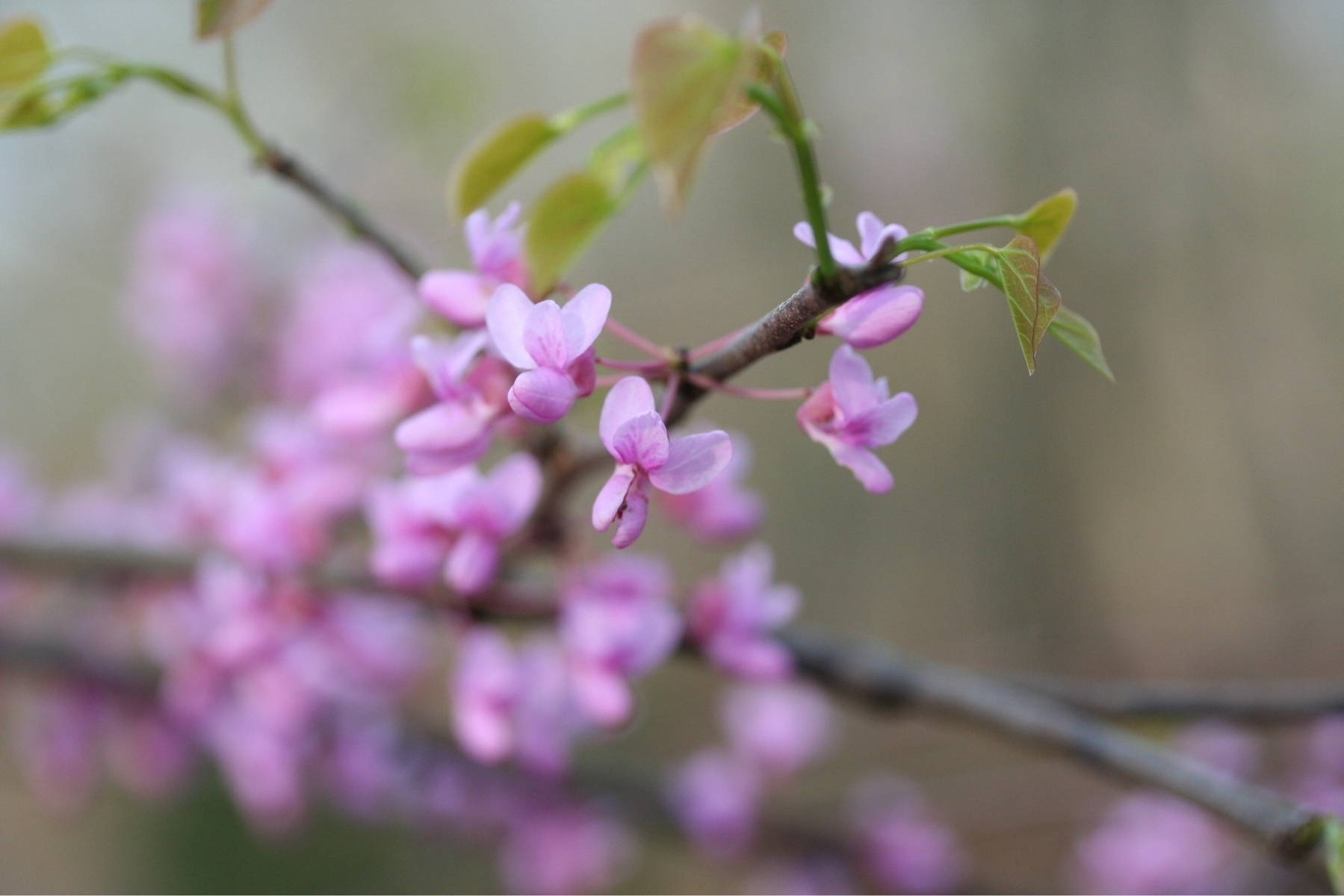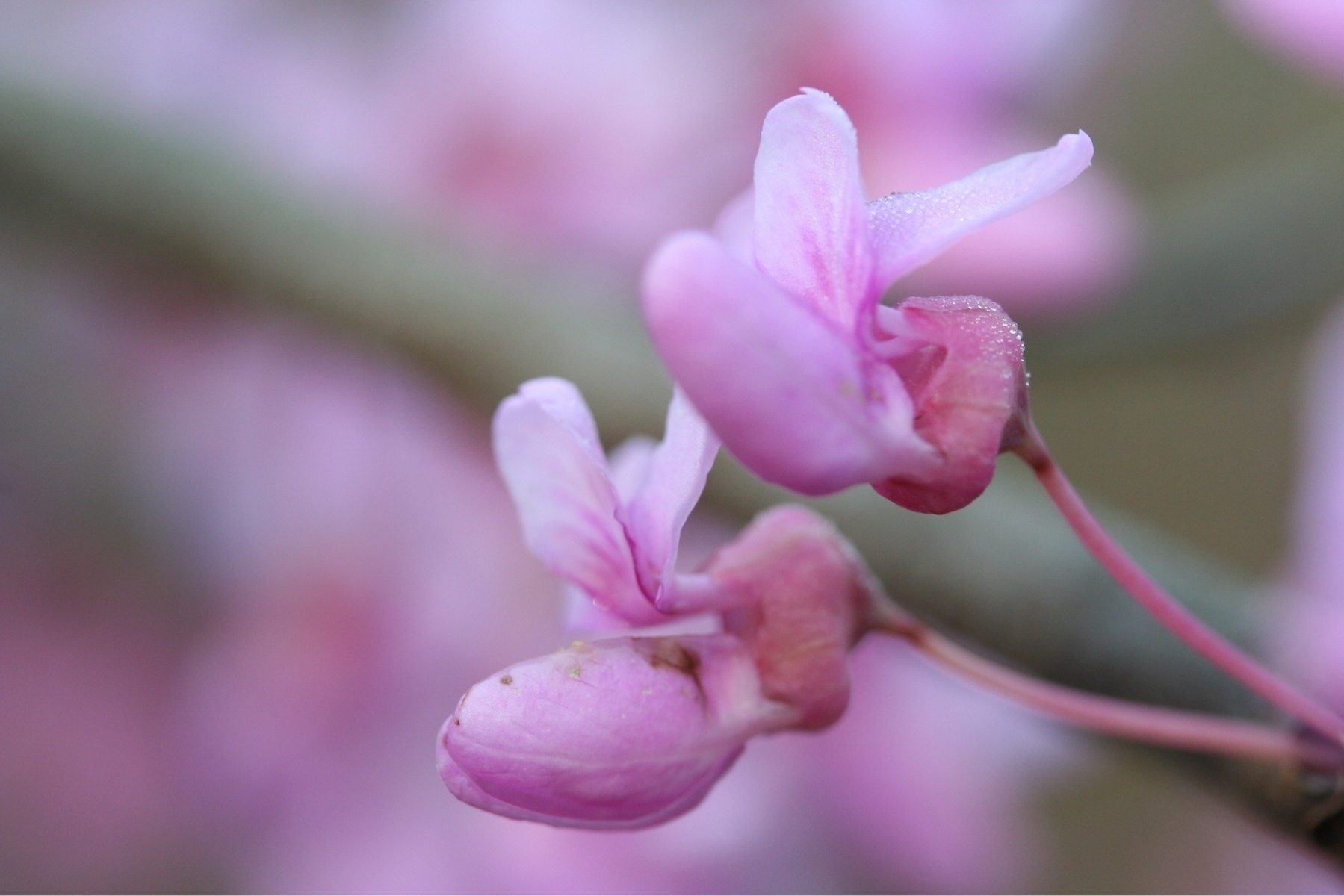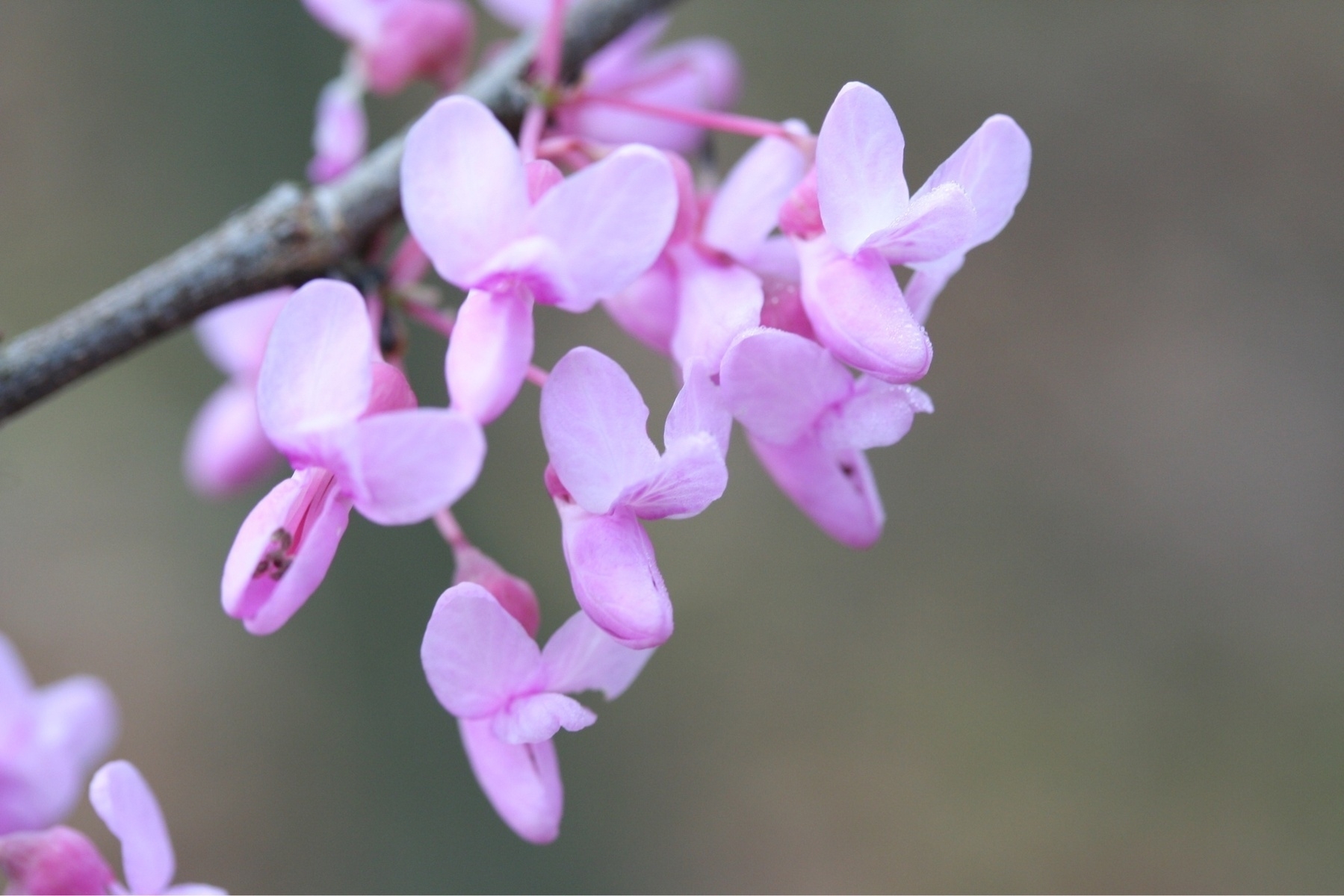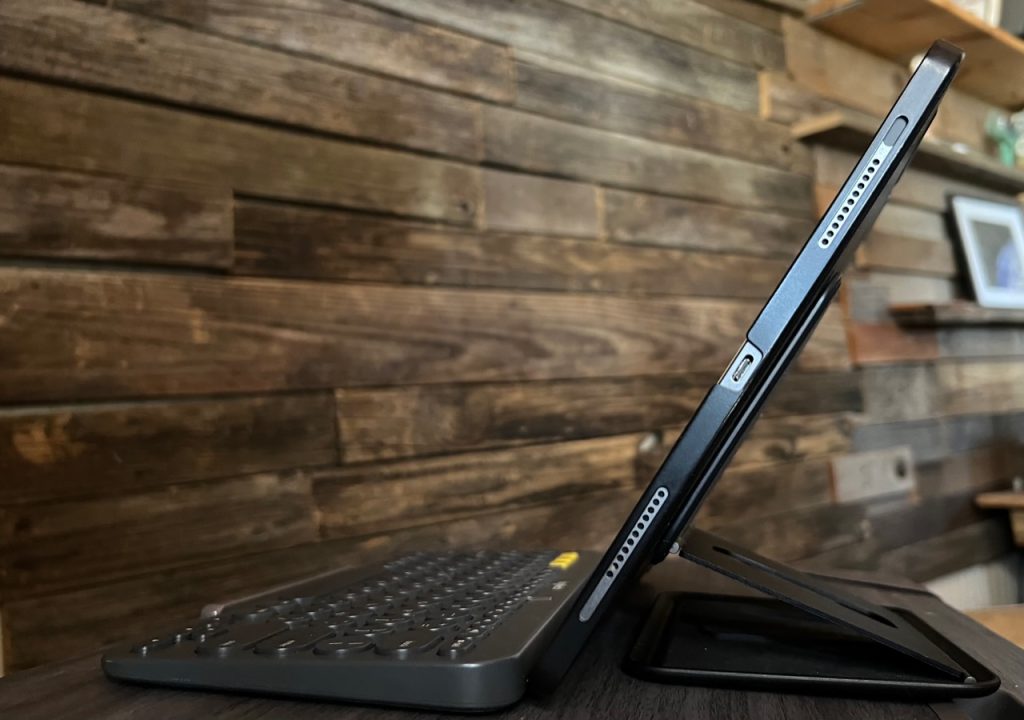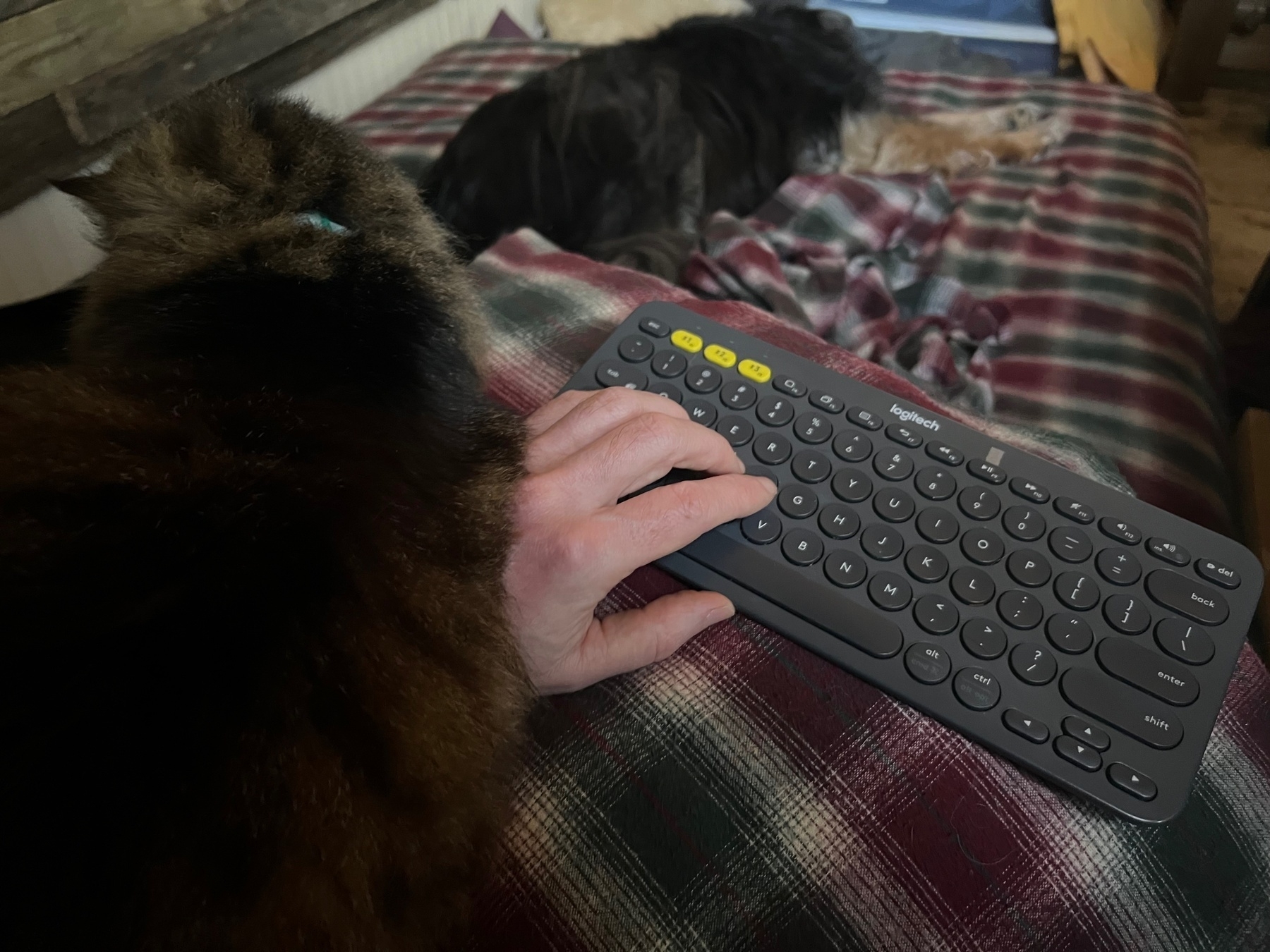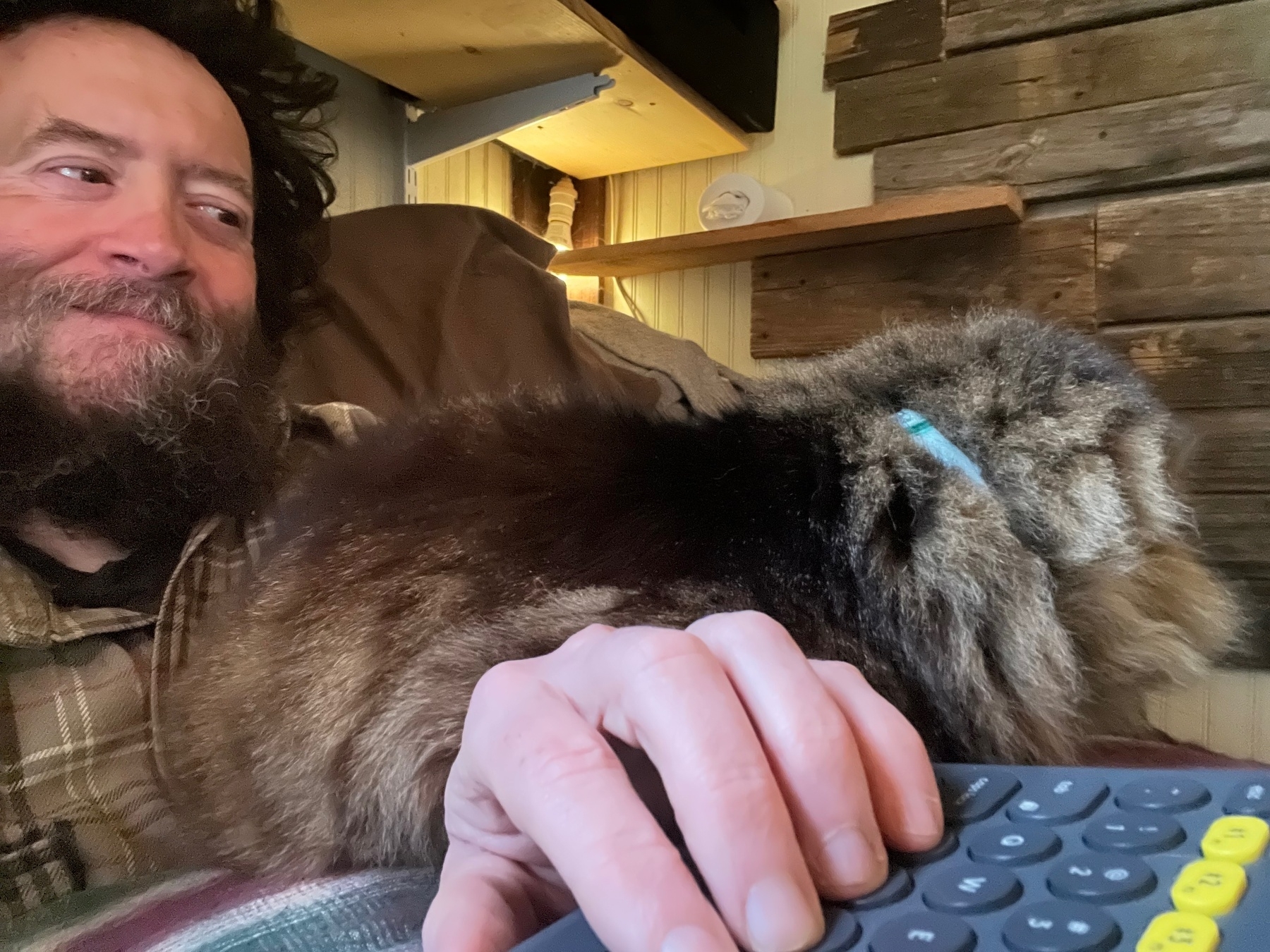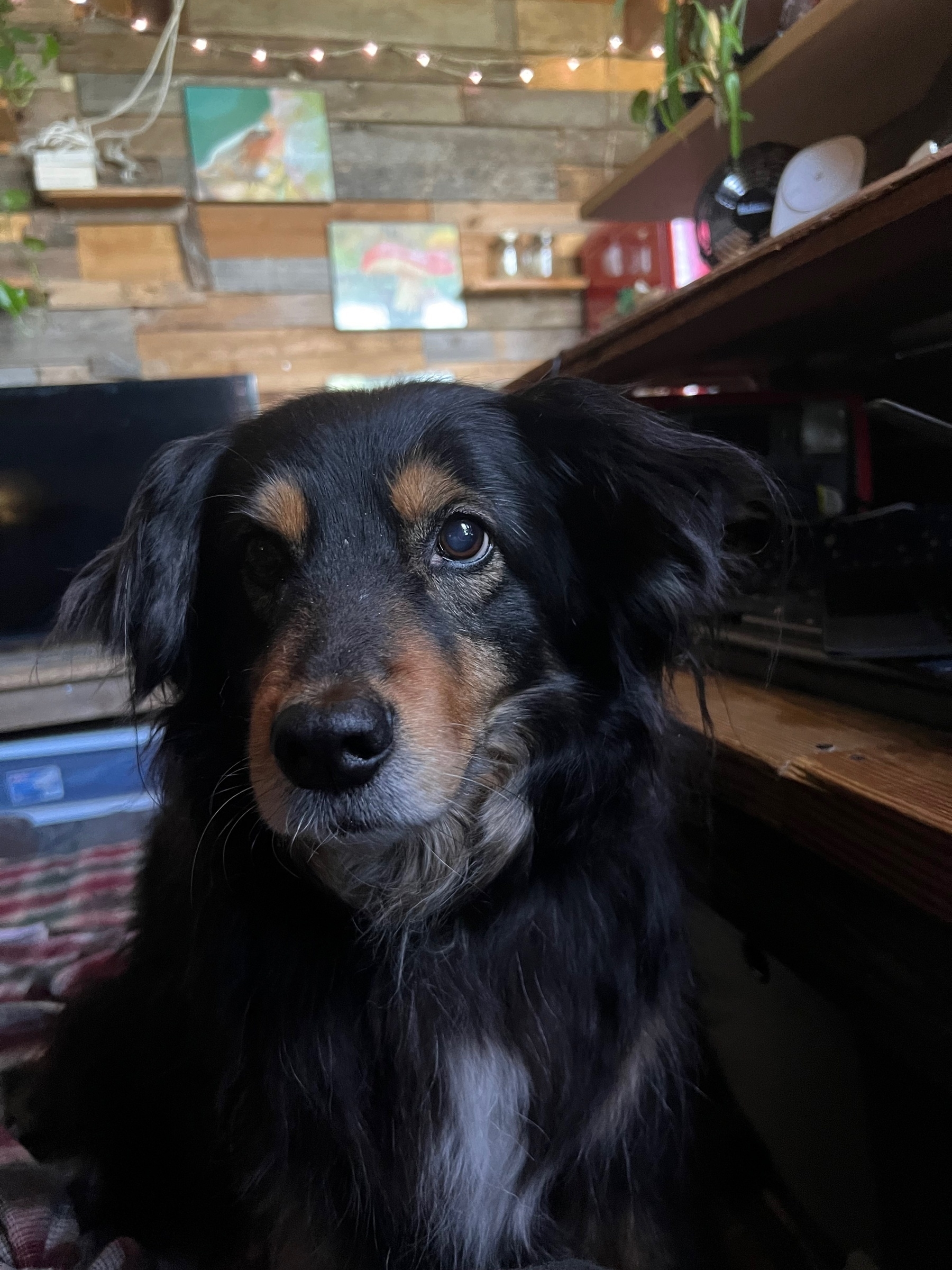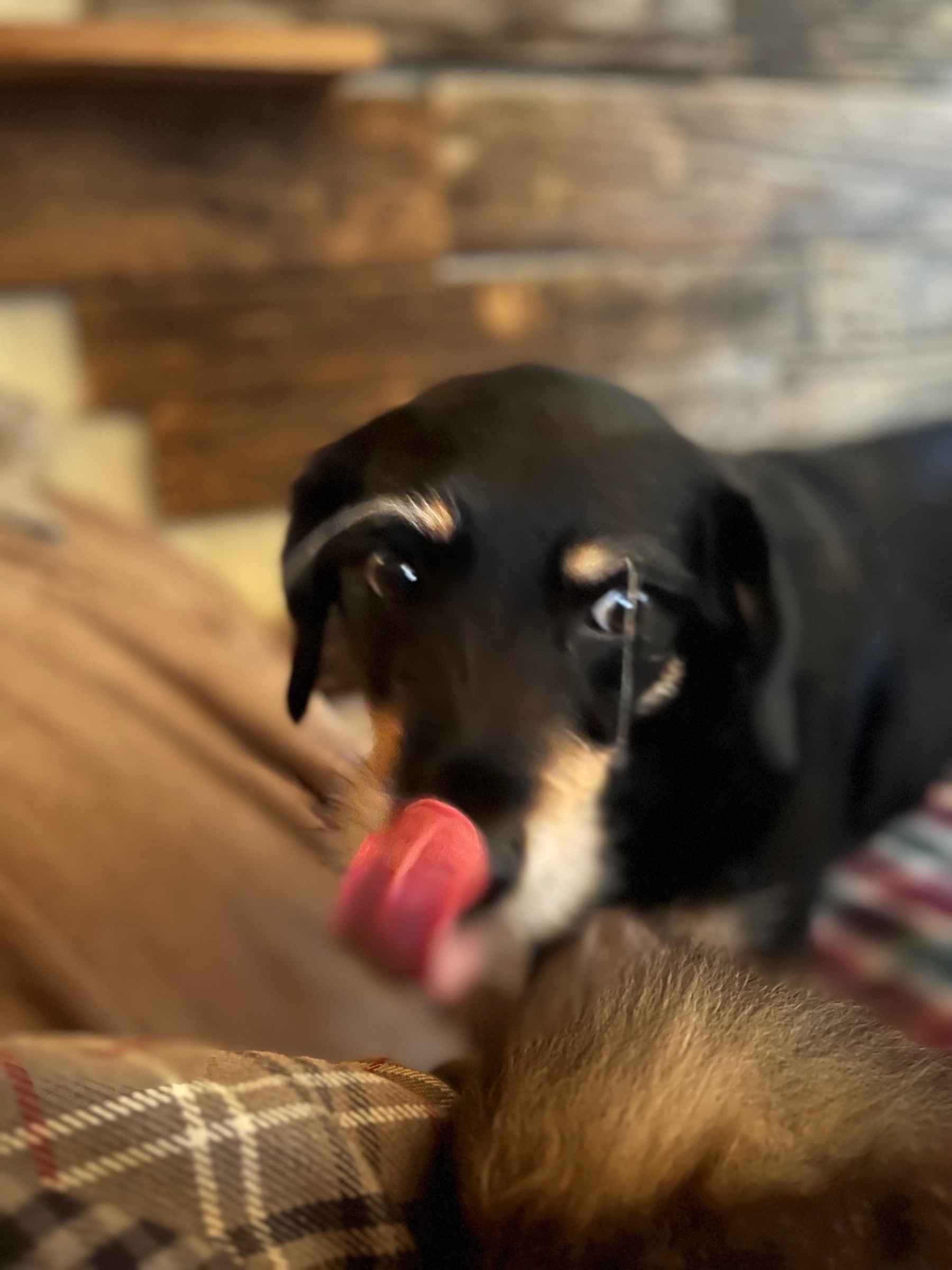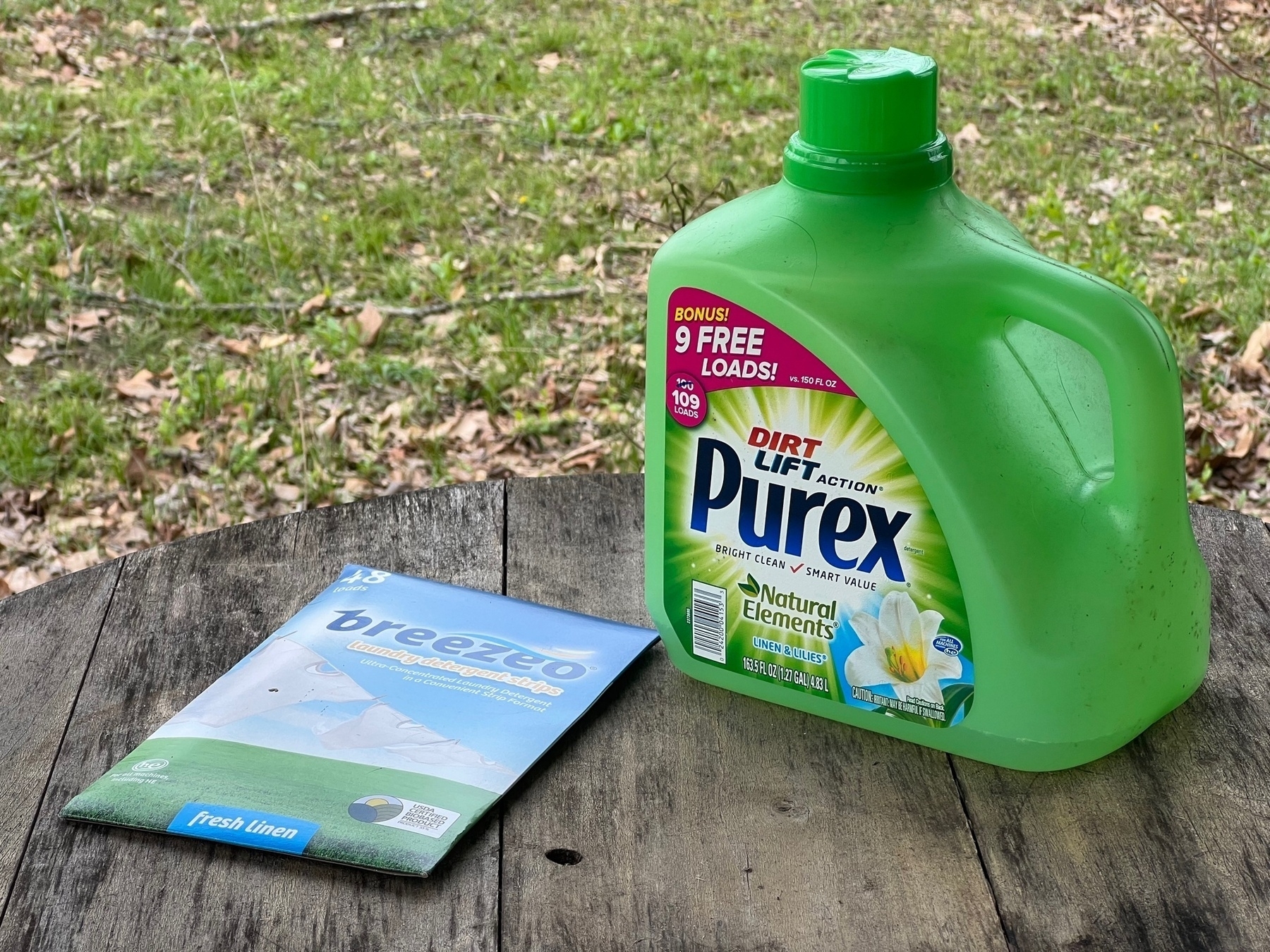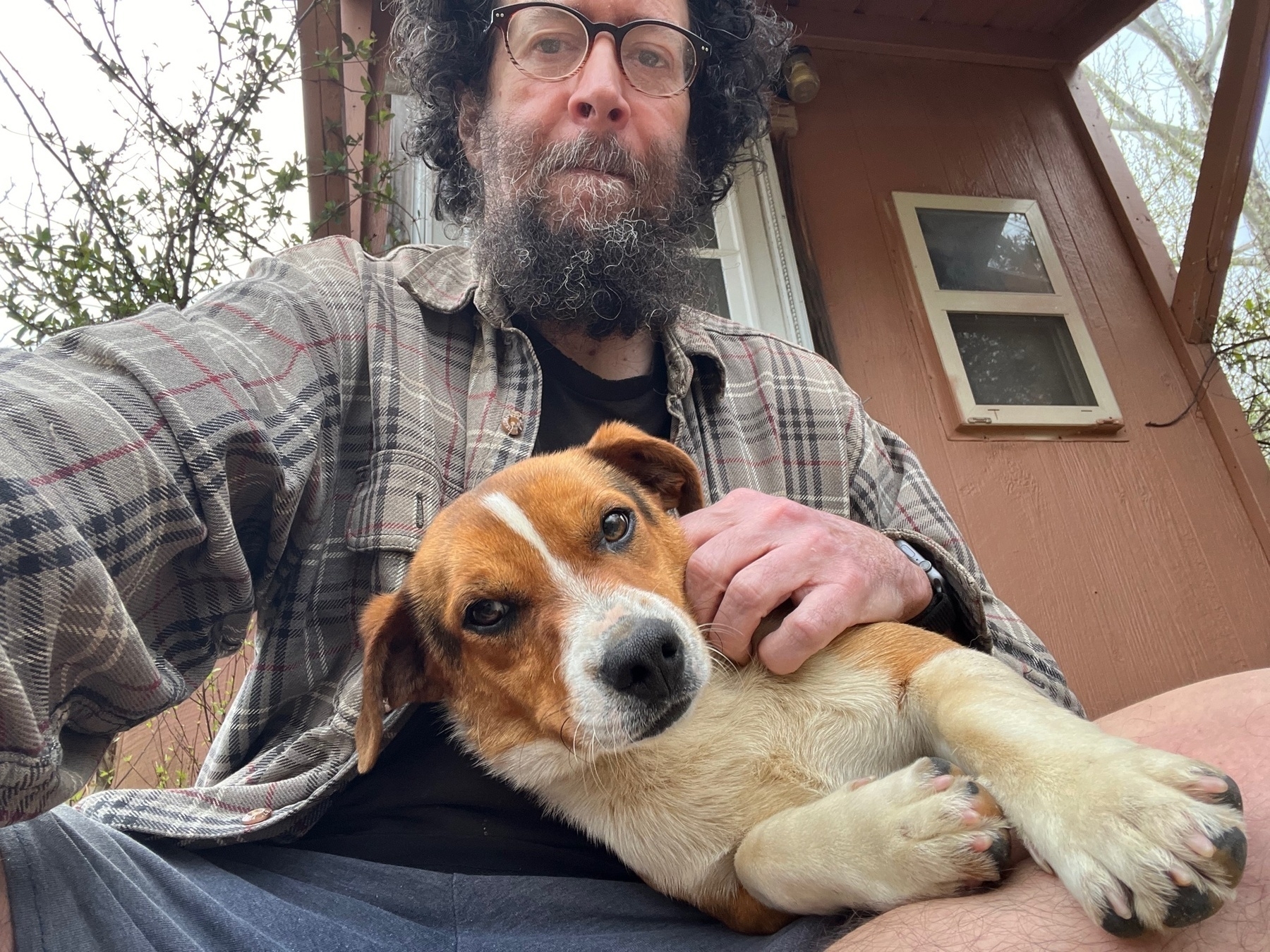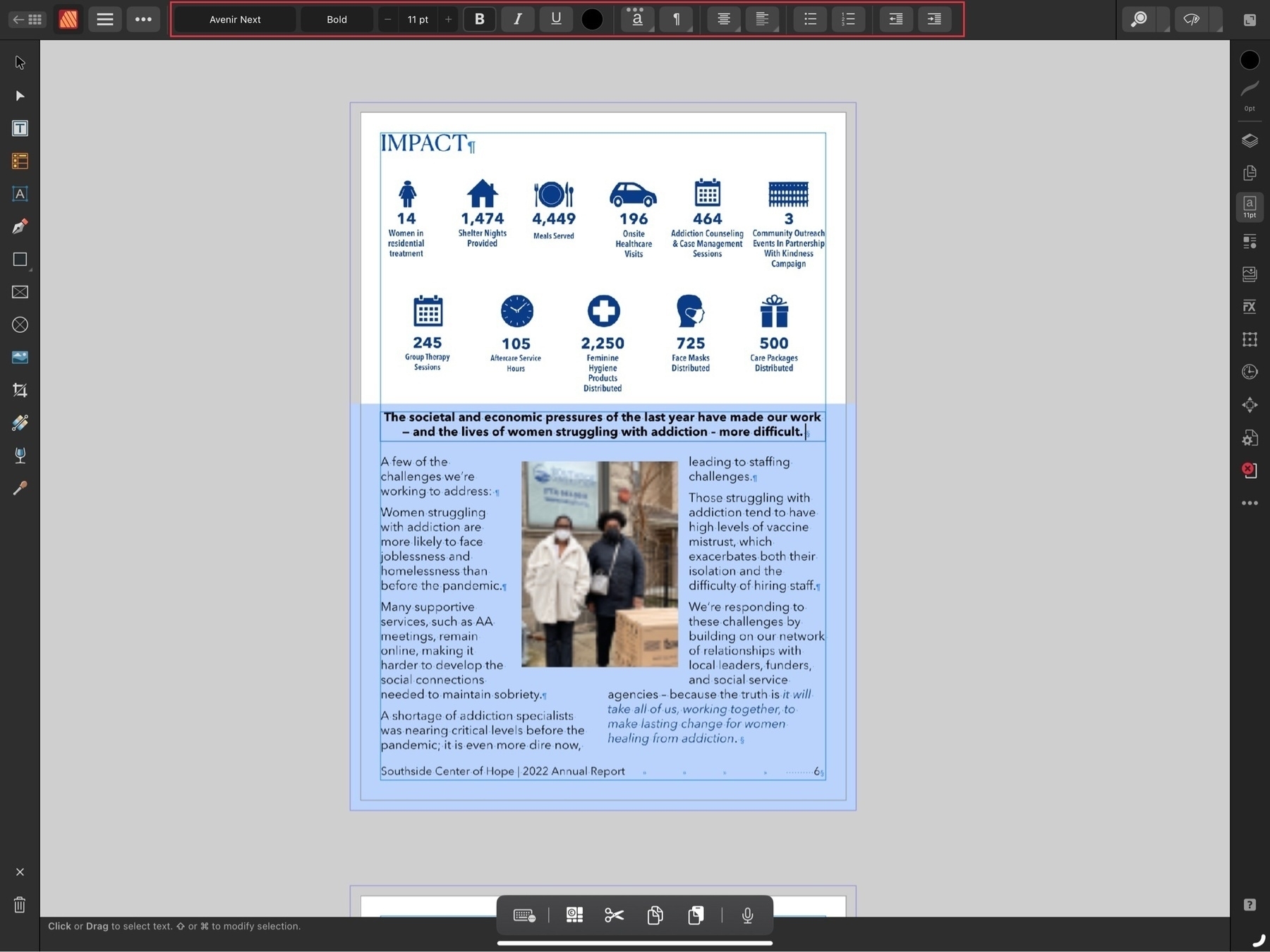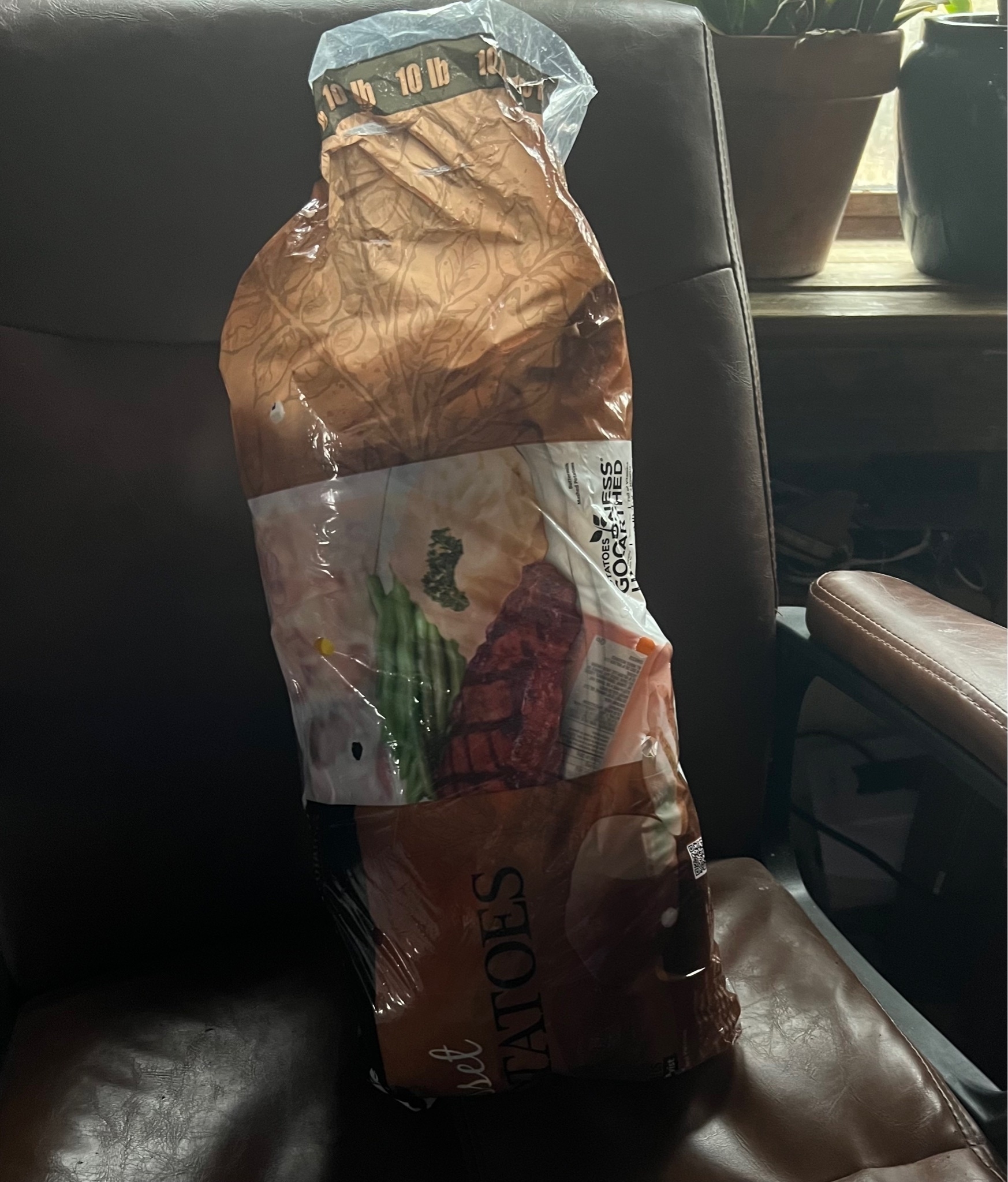Moft Snap Case and Snap Float Stand Review
Several months ago I decided to try out a couple of iPad accessories from Moft. They have a series of products called the Snap System that are designed to work together. I bought the Snap Case and the Snap Float Stand. The various items can be purchased separately or in bundles. Their website is a little confusing when trying to create bundles.
Of the various iPad accessories I’ve tried over the years I think this pair is my favorite. While I spend some time at a desk I’m often on a futon/beanbag and this combination works great in both places. In both situations it works well to be propped up at various angles in the horizontal or portrait positions. The float stand is also a kickstand that can be used in so many different orientations that it is basically without limit. And it’s very stable on a pillow in my lap.
A fairly typical configuration over the course of a day:
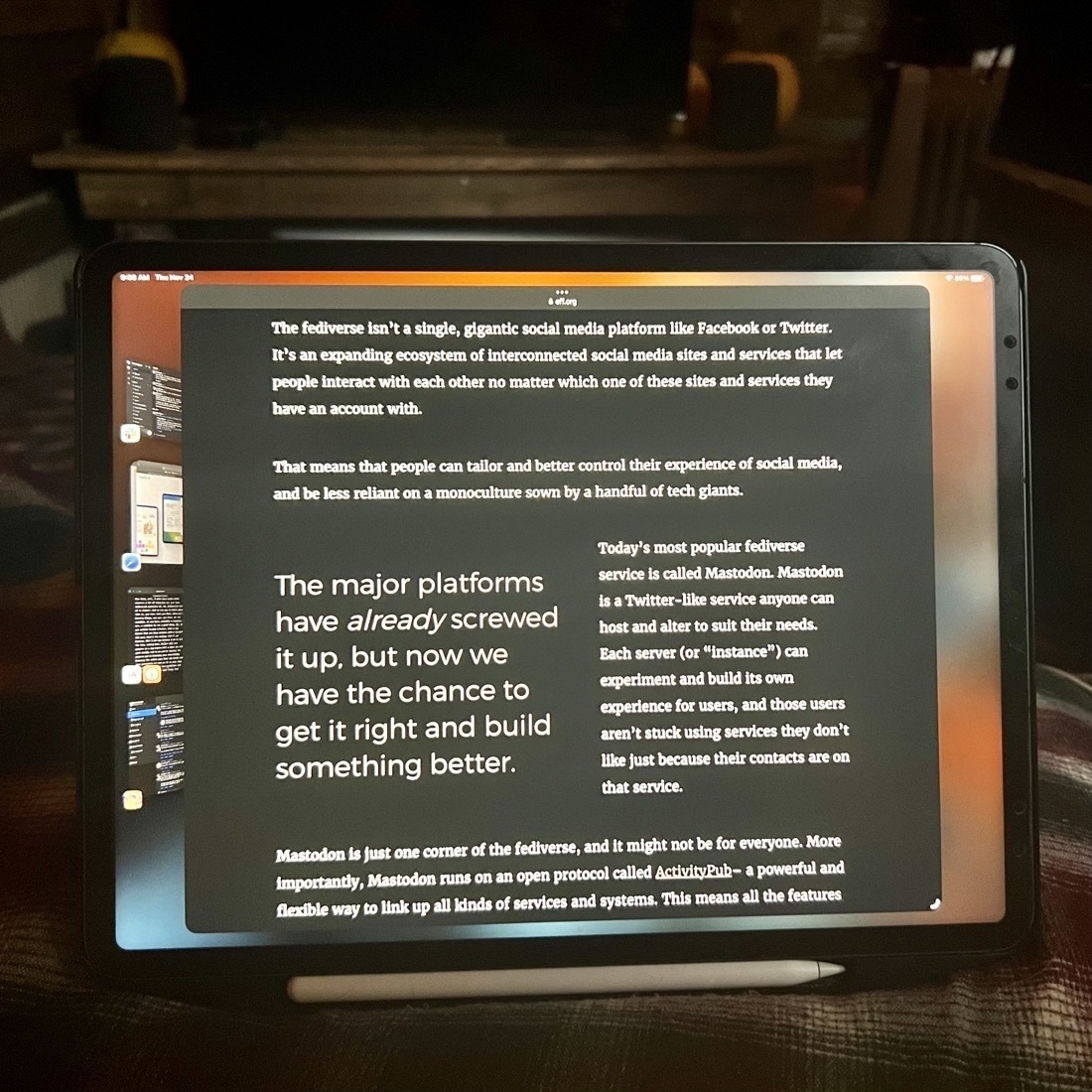
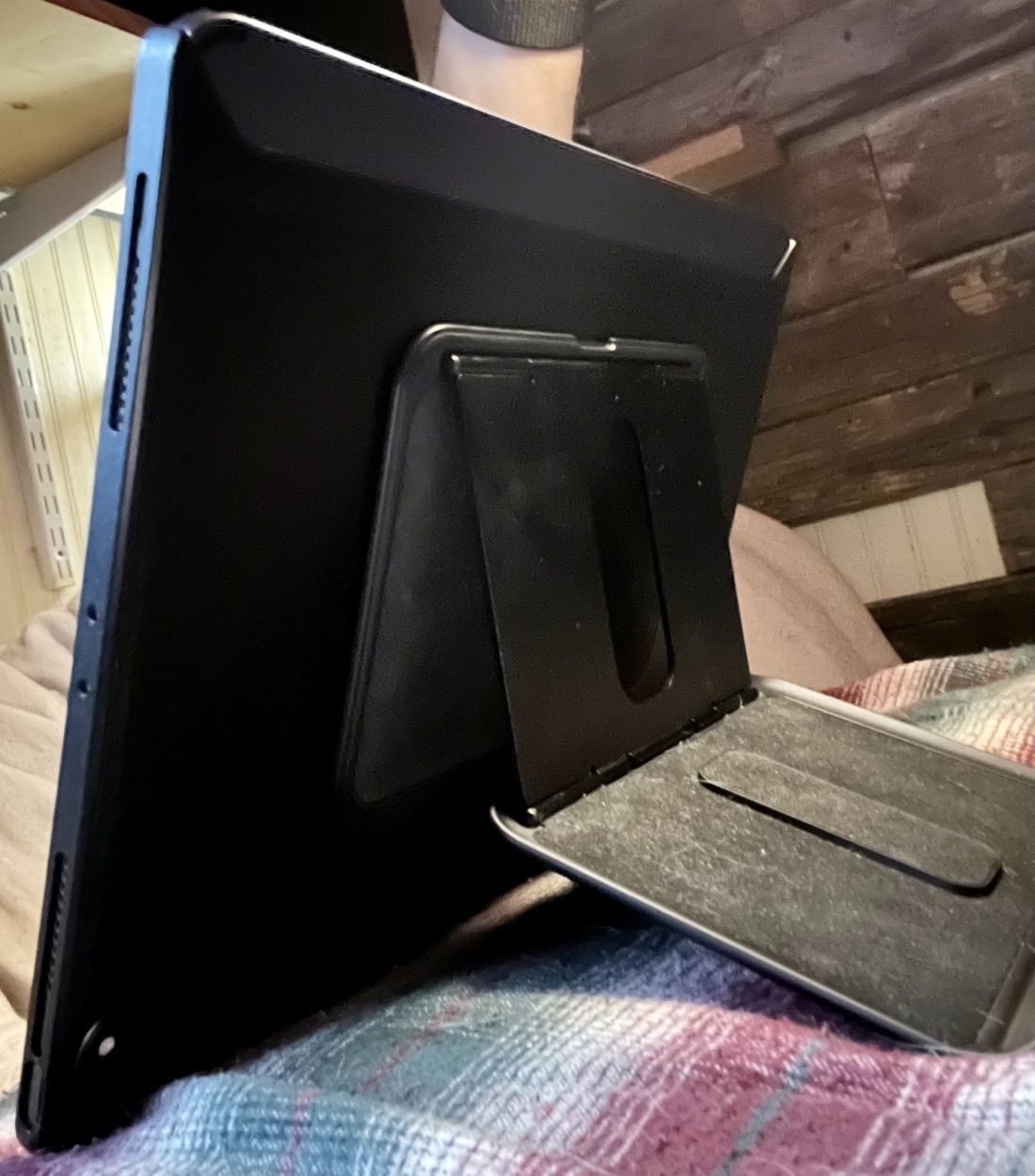 iPad propped up in horizontal position, Pencil attached at bottom. This is nice as it keeps the bottom of the screen up off of the pillow and accessible for swiping.
iPad propped up in horizontal position, Pencil attached at bottom. This is nice as it keeps the bottom of the screen up off of the pillow and accessible for swiping.
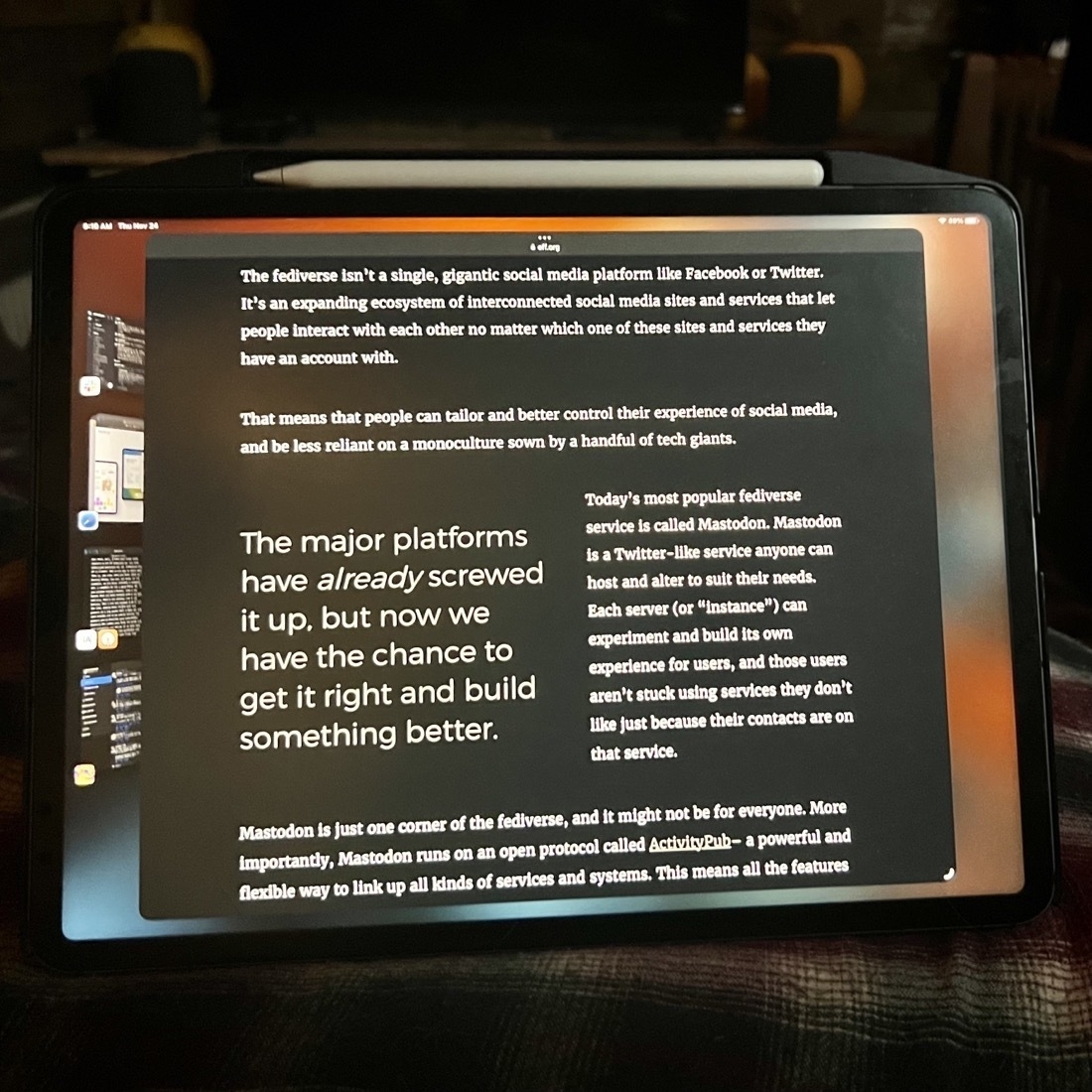 Flipped, the pencil on top.
Flipped, the pencil on top.
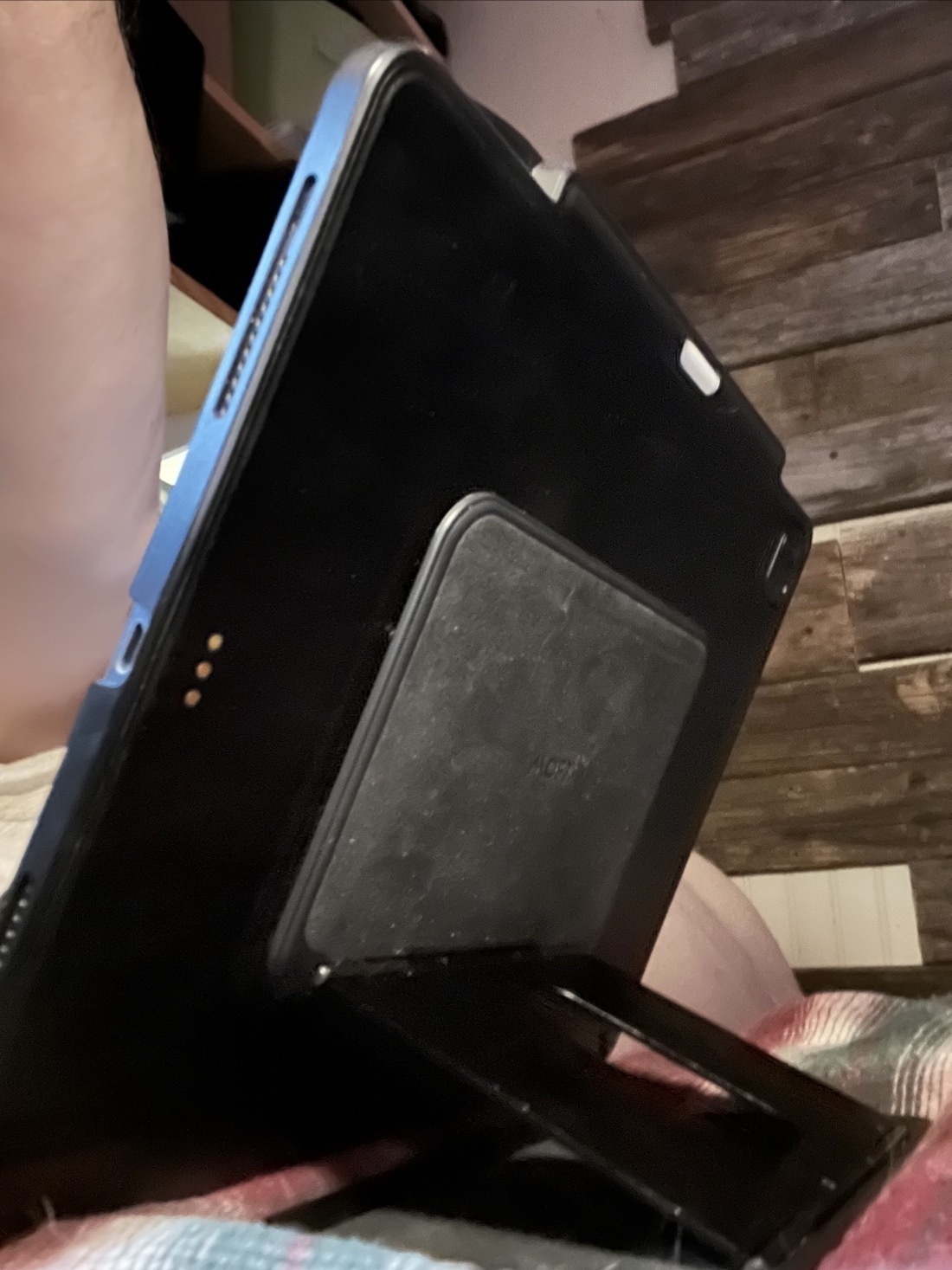 iPad propped up in horizontal position, Pencil attached at top
iPad propped up in horizontal position, Pencil attached at top
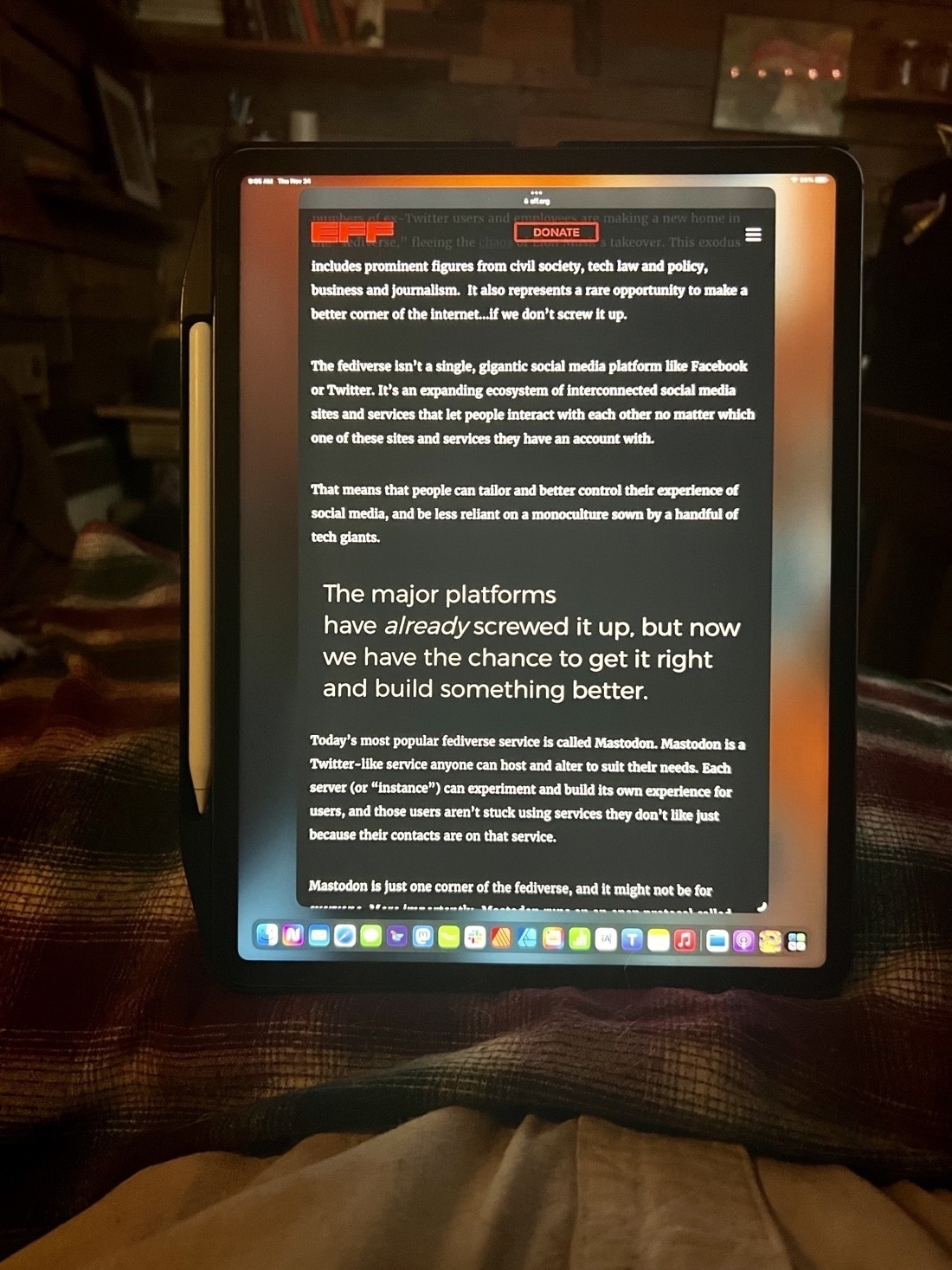
 iPad propped up in portrait mode
iPad propped up in portrait mode
I find that with this case and stand I’ve been using the iPad as a tablet far more because I like having it propped up but without a keyboard in the way. If I want a keyboard I can just reach over and grab it. If I want a keyboard/trackpad I can attach it to the Magic Keyboard which is also nearby.
Because the stand and case are magnetic the stand pulls away easily. I did find that the embedded magnets in the Snap Case were not as strong as I wanted them and I was getting accidental detachments when readjusting the stand angles. Moft includes an extra sticky metal plate with the stand so I attached that to the case as it provides a much stronger connection that never comes off accidentally.
The Snap Case is really thin and Apple’s Magic Keyboard attaches just fine to the Snap Case and closes too though it bulges a bit with the added thickness. That said, because the case is so thin it’s not going to provide much protection in a fall though it does provide a bit protection in terms of daily wear along the edges and back-side.
A few last notes. First, the case also has a convenient spot for the Pencil. If you have a Pencil and like keeping it close by this is a nice addition. It also serves as an extra place to hold the iPad. Second, while the case provides access to the 3 buttons on the outer edges of the iPad it makes it fairly difficult to actually press those buttons.
In terms of durablity, I’ve been using the stand for most of the past 7 months and it’s held up very well. The hinges are as solid as the day I started using it.
Furballs
Too many furry critters to work from bed this morning. Rosie started it when she decided to nap on my hand. 🥰
The temperature of the world’s ocean surface has hit an all-time high since satellite records began, leading to marine heatwaves around the globe.
“The current trajectory looks like it’s headed off the charts, smashing previous records,” said Prof Matthew England, a climate scientist at the University of New South Wales.
Three years of La Niña conditions across the vast tropical Pacific have helped suppress temperatures and dampened the effect of rising greenhouse gas emissions.
‘Headed off the charts’: world’s ocean surface temperature hits record high | The Guardian
I've written several times about reducing waste. I don't wash my clothes as often as most people and when I do I tend to dilute so this jug has lasted me for a long time. Going forward I'll be using soap strips that come in paperboard. Imagine the energy/waste saved if millions did the same.
Livestock make up 62% of the world’s mammal biomass; humans account for 34%; and wild mammals are just 4%.
A diverse range of mammals once roamed the planet. This changed quickly and dramatically with the arrival of humans. Since then, wild land mammal biomass has declined by an estimated 85%.
Humans are now the dominant species.
We see this when we look at the distribution of mammals across the world today.
Wild mammals make up only a few percent of the world’s mammals - Our World in Data
I have some bad news. Civilization is going to collapse. Not in 1000 years, not in 100 years, but within the lifetimes of most people alive today.
It doesn’t necessarily mean humans will go extinct, but at the very least, billions of people are going to die from disease, violence, starvation, dehydration, natural disasters, and war.
How do I know this? Because it has already begun.
Our global industrial civilization has been headed for collapse for at least 50 years…
Overshoot: Why It’s Already Too Late To Save Civilization | Medium
Off the coast of Antarctica, trillions of tonnes of cold salty water sink to great depths. As the water sinks, it drives the deepest flows of the “overturning” circulation – a network of strong currents spanning the world’s oceans. The overturning circulation carries heat, carbon, oxygen and nutrients around the globe, and fundamentally influences climate, sea level and the productivity of marine ecosystems.
But there are worrying signs these currents are slowing down. They may even collapse.
Torrents of Antarctic meltwater are slowing the currents that drive vital ocean overturning
Trump may be the first former president to face criminal prosecution, but that fact in and of itself is a damning condemnation of the U.S. system of impunity that has long permeated our system of American exceptionalism.
This case against Trump would be a mere footnote of history, albeit a wild one, if the U.S. actually believed in holding presidents and other top officials accountable for their crimes, including those committed in office.
A four-part, independently produced docuseries looking under the hood and into the operations of mutual aid efforts across North America.
Struggling to build in a collapsing system, hear the perspectives of over a dozen groups who explore the origins, structures, healing ways, and logistics of collective organizing.
For some reason, my tiny little corner of the world seems to be a dog attractor. It's like a black hole, but for dogs. I try to find their people and if that fails I find them homes. Yesterday this little fella showed up with friends. They left, he didn't. I'm calling him Buddy.
The expanded alliance supporting e-bikes reflects an evolution in the priorities of environmental groups. After focusing largely (some might say myopically) on electrification as a pathway to decarbonize transportation, many climate advocates are ready to lobby for less driving, period—not just less gas-powered driving.
Transportation has long been a major source of greenhouse gases in the United States, with cars and light trucks producing more than half of such emissions.
E-bikes credit: How the environmental groups finally learned to see a future with less driving.
A small but welcome change that came with iPadOS 16.4, when using Stage Manager the Homescreen is no longer blurred behind app windows. 🤓
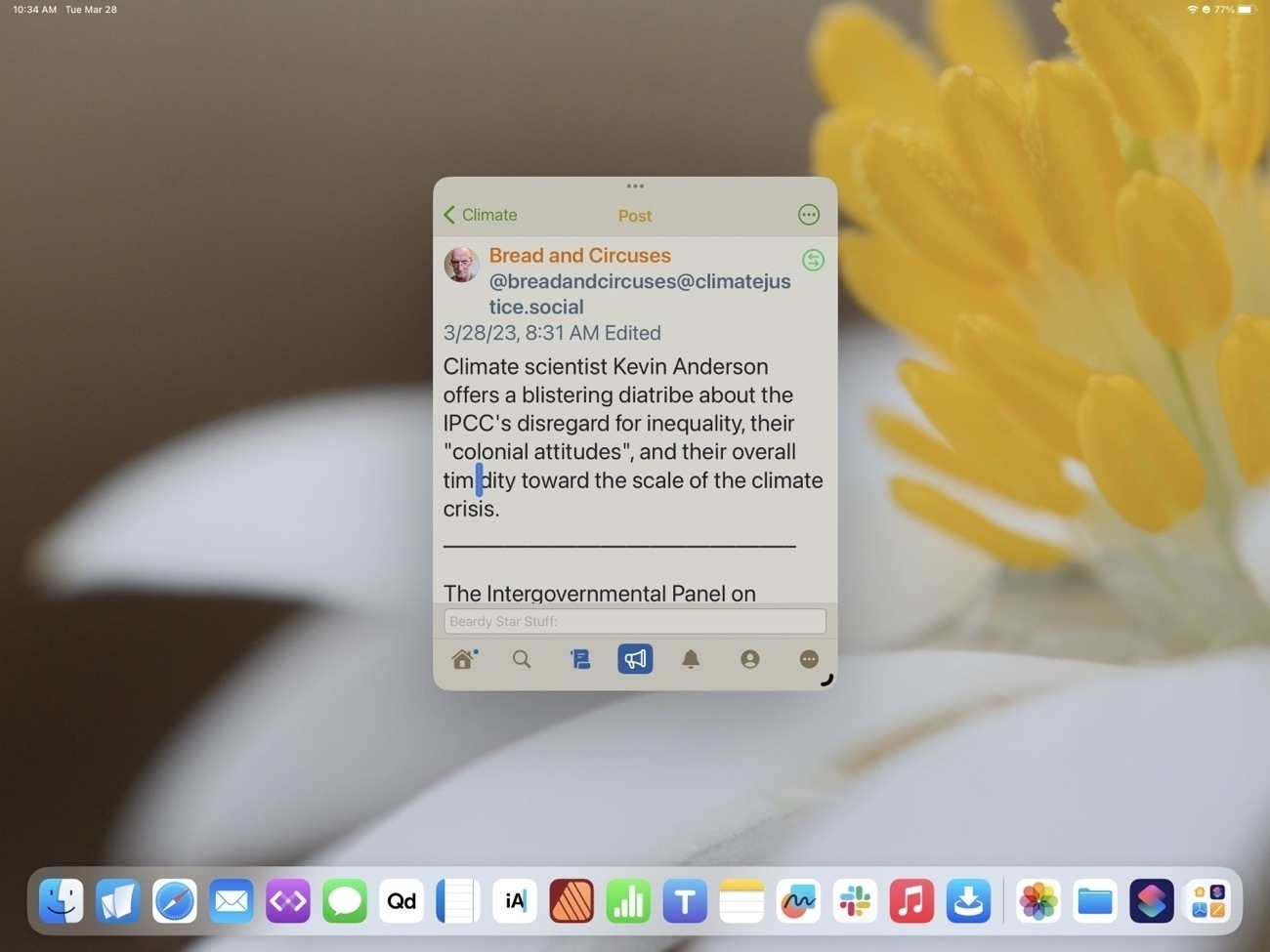
The Greenland Ice Sheet covers 1.7 million square kilometers (660,200 square miles) in the Arctic. If it melts entirely, global sea level would rise about 7 meters (23 feet)…
“The first tipping point is not far from today’s climate conditions, so we’re in danger of crossing it,” said Dennis Höning, a climate scientist at the Potsdam Institute for Climate Impact Research who led the study. “Once we start sliding, we will fall off this cliff and cannot climb back up.”
The Greenland Ice Sheet is close to a melting point of no return - AGU Newsroom
Forest-nesting songbirds were found in increased numbers in urban parks. Eventually it became clear that city lights were reshaping migration, especially in autumn when young birds on their first migration were being drawn by artificial urban light, which is “visible to a flying bird from as far away as 190 miles.”
Protecting migratory birds in Missouri can be as easy as flipping a switch • Missouri Independent
My Affinity Publisher for iPad Review
Serif has set a high bar with the Affinity apps on the iPad and Publisher allows all three to work together seamlessly. And at a time when Apple pundits continue to doubt the potential of the iPad as a powerful tool for creative work, Serif demonstrates what is possible.
If only those pundits could occasionally step away from churning the rumor mill for a bit they might actually discover there are still innovative…
Affinity Publisher for iPad Review
Back in November I published a mini-review of Affinity Publisher for iPad.. At the time I’d only had a week to work with it but was happy with the app. It’s now been four months and I thought I’d offer an update. Serif have released 4 small bug fixes but most of the larger bugs have yet to be fixed. In my experience there have been just three bugs that have been a bit of a bother. The first, some fonts show up in Chinese characters instead of being displayed in English. Second, sometimes the app stops taking input from an external keyboard, restarting the app fixes the issue. The third really isn’t a bug at all because it’s specifically a problem related to using the app on an external display which Serif have said is not yet a supported feature. For now using the app on an external display is useless because the the right side context toolbar disappears anytime a tool is changed using the left side toolbar. Technically Stage Manager isn’t supported at all but I’ve found the app works fine with Stage Manager turned on.
In general the app has been very stable and usable in my four months of use. And to be clear, it’s not just usable, it’s smooth and responsive on the M1 iPad, 8GB of memory. Being able to work with touch, Pencil and trackpad is a real pleasure.
The foundation of Publisher was put down in 2019 with the desktop version of the app. It was a solid foundation offering excellent performance and a well rounded feature set.
Where Publisher really shines is in multi page documents and it has not disappointed in that role. Newsletters, reports, brochures, magazines or anything of that sort. I’ve also been using it for all my single page documents as it has linked text boxes and text wrap, two features not found in Affinity Designer which is what I would have used for single page designs previously.
The usual tools one expects to have with this kind of app are on the left toolbar. As you would expect, as you change tools the top toolbar changes to reflect the options associated with the selected tool. On the right side is a vertical stack called the context toolbar represented by icons that allow for the full range of options you need for whatever tool might be selected. So, for example, when you’re working with text you’ll see the most common tool options in the top tool bar but most of the options are only visible when you click to the text tool button on the right side context toolbar. Note all of the disclosure > icons on the right side. Tap into each one for another menu of text related options. Just as they did with Affinity Designer and Photo, Serif have done an excellent job translating the desktop interface to the iPad.
A powerful app like Publisher, by definition is more complicated than many other apps. I’ve seen people complain that Pages is too complicated and, well, Publisher does far more than Pages. This isn’t an app you’re going to open for the first time and suddenly understand. It can take some time to learn and remember all of the options. It took me several days of repeated use to remember which sub menus in the text tools contained which options. But as you use it you’ll see that the submenus are organized with purpose. For example, when I tap into the Leading disclosure triangle the resulting submenu is appropriately titled Spacing and it’s here that I can change the spacing around paragraphs and other options.
A word of advice if you’re just getting started, the built in help is also available on the web and it can be useful to have that open as it allows you to bounce back and forth between the app and the help while you’re working. The built in help system is located within the main app home page and unfortunately it’s not possible to access the help while working on a file In addition to the help Serif has also posted quite a few Publisher tutorial videos on their YouTube channel and these are worth checking out.
[caption id="" align=“aligncenter” width=“2048”]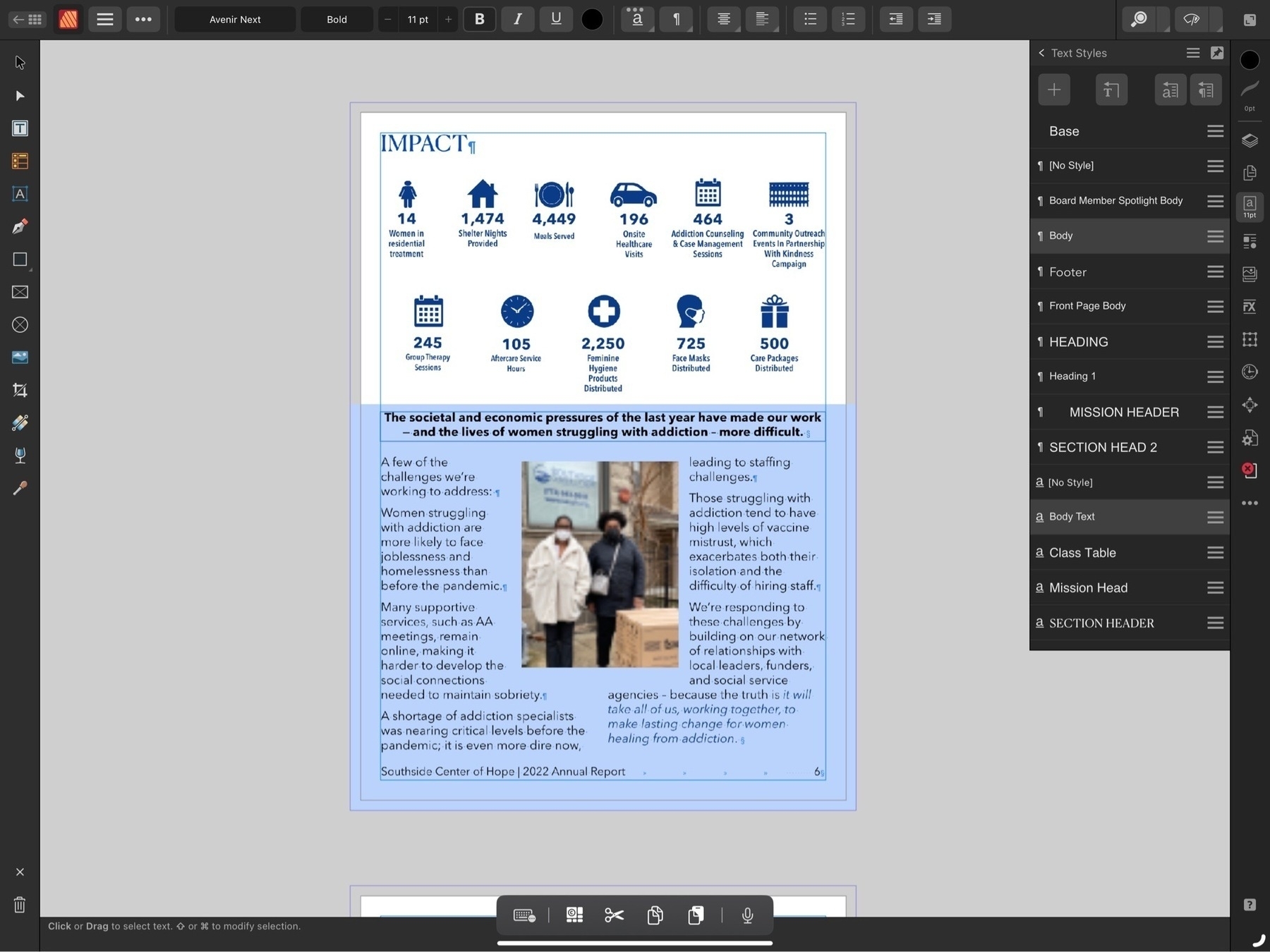 Another submenu while working in the text context sidebar is character and paragraph styles[/caption]
Another submenu while working in the text context sidebar is character and paragraph styles[/caption]
For many iPad users Apple’s Pages app is all that’s needed. That app has also had many features added over the years and is quite capable for laying out documents. I used it for years designing a wide variety of reports, newsletters and brochures. Affinity Publisher is a competitor to Adobe’s InDesign. It will open InDesign IDML files as well as pdfs for conversion to Publisher files.
Unlike Adobe’s various iPad apps, Publisher on iPad is the full app with the full feature set. Should you want to edit a Publisher file shared by someone or share to someone using Publisher on a Mac or Windows, it’s no problem as long as the file will be opened with version 2 of the app on those platforms (Files created by Publisher 2 or any of the Affinity 2 apps are not backwards compatible so cannot be opened by the version 1 apps. If you’ll be sharing a file with someone else be sure to confirm that they’ve updated to version 2 of the app).
Not only are files cross compatible between iPad, Windows and Mac, but all three apps of the suite can open files from the other apps. So, for example, it’s no problem to open a Designer or Photo file in Publisher. The file can continue to be edited and saved in its original format.
[caption id="" align=“aligncenter” width=“2048”] Notice the Publisher icon in the top left has been replaced by the Photo icon. Also the sidebars reflect the tools found in Affinity Photo.[/caption]
Notice the Publisher icon in the top left has been replaced by the Photo icon. Also the sidebars reflect the tools found in Affinity Photo.[/caption]
The last feature I’ll mention is perhaps one of the best. StudioLink, allows me to open up an a vector graphic in Designer or an image in Photo without actually leaving the Publisher app. It’s an amazing feature though it does require that you have all three apps installed to work. From within the Publisher app the other two apps are referred to as “Personas”. Open them up as needed by tapping the Publisher icon in the top left of the window where you’ll see a dropdown menu showing the other two apps. Choose the other app you need and the Publisher toolset will instantly change to the tools and features found in the other apps. Make adjustments to images from the Photos Persona, create advanced vector graphics or edit embedded vectors from within the Designer Persona. You have the full range of the tools found in the app you’ve “switched” to. When finished just tap back to the Publisher Persona to return to page layout. The transition is seamless and instant.
Serif has set a high bar with the Affinity apps on the iPad and Publisher allows all three to work together seamlessly. And at a time when Apple pundits continue to doubt the potential of the iPad as a powerful tool for creative work, Serif demonstrates what is possible.
If only those pundits could occasionally step away from the churning the rumor mill for a bit they might actually discover there are still innovative developers working hard to create valuable tools used by real people in the real world.
Serif’s Affinity 2 apps continue to be a fantastic bargain. Buy single apps or buy the universal license and use the Mac, Windows or iPad apps, no subscription, these are a one time purchase.
My waste reduction effort
This is about 8 weeks of waste. Not in this photo are the steel cans that are recycled and paperboard food packing this is composted and used as mulch. The key is eliminating products that only come in hard plastic containers. I've also cut out glass.
Living as though the future mattered
I write this in 2023 when our climate emergency has become increasingly obvious to everyone. No longer is it just climate scientists and activists that are taking note. But we’re all aware now aren’t we? Those of us that agree with science and who are observing nature are living in a state of constant climate anxiety. Personally, I can say it’s on my mind all of the time as a sort of background dread.
It’s hard to be honest and also find hope as our current trajectory is very much in the wrong direction and there are no signs that our political, cultural or economic systems are prepared to move us in the opposite direction. Truthfully, we’ve given up before we ever really started. Most of us see that our political systems have failed and we have no hope that they’ll suddenly shift course. But we ourselves are a part of that problem. We accusingly point our fingers at politicians, corrupted political processes, corporations and then we throw up our hands proclaiming there’s nothing we can possibly do. We put on a show of being frustrated and angry but then we go along with the convenient way of life we’re used to. We let ourselves off the hook. We take no responsibility.
We are dooming not just ourselves but future humans. It’s deferred violence. Imagine stepping outside with an all powerful gun, aiming it up into the sky and sending a spray of bullets up into the sky. With this particular gun though we can be certain that every bullet will come down and every bullet will find a target. That’s our inaction. That’s our convenience. Our way of life is causing current and future destruction, misery and death.
And it’s long past the time that we stare into that deep, dark truth. It’s time we squarely face our role in it and stop making excuses about how we’re powerless. Our action has been to doom others. Children, grandchildren, other species-to not just suffering, but in some cases, to extinction.
We’ve already committed ourselves to 1.5 degrees of warming and all evidence is that we’ve likely committed to something much worse. The burning truth of our relatively near future will be human, ecological and planetary catastrophe.
All that said if 300 million US citizens lived as though the future actually mattered, if we would commit to real and yes, drastic changes to our lives, we could at least begin to turn the ship. We can begin the process of adapting and getting used to new realties. We, the people, must lead because waiting for the political process to fix THIS problem is folly.
I can see no higher purpose than to live as though the future mattered. To do otherwise, is to be complicit in the worst possible crimes. We can begin now. Our everyday choices can be choices based on restraint. We can do with far less and we can commit to being uncomfortable now, to begin to offset the worst case futures. We don’t do this alone. We encourage one another. We share resources. We talk and comfort one another. We can build a better world starting today by doing less, consuming less, driving less, flying less. Far, far, far less. Our goal and our commitment is to get to zero emissions. ZERO. Think about that. Really let it settle in. Reconcile with it. That is the necessity.
But even that isn’t enough. Frankly, those of us that live in the US, those of us that live in the “developed world”, we also owe the future, our fellow species and our neighboring humans in developing nations an apology and our humility. For all of our finger pointing at the rich, the politicians, the corporations, many millions of us have continued to insist on a convenient life as a right. And that’s a part of the crime we’ve committed.
Let’s take a step back from the brink. Pause in our lives and confront what we’ve done, what we’re doing.
Now let’s live as though our future matters.
Note about this post: Not surprisingly I recently shared a climate-related article and in the discussion that followed something I wrote resonated with folks. Patrick suggested I share in a stand alone blog post so, this is me doing that.

